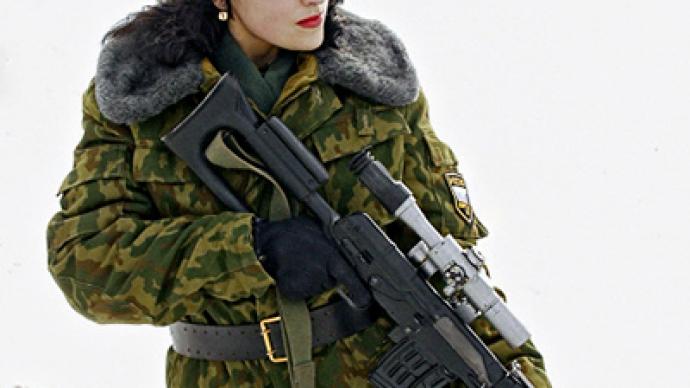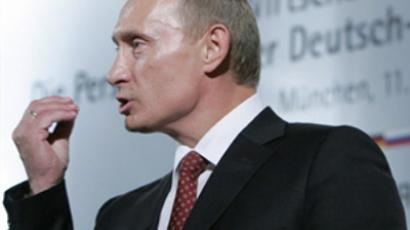Russia pulls out the big guns

As talks between NATO and Russia over a joint missile defense system remain stuck in the mud, the Russian Armed Forces are leaving nothing to chance, beefing up their arsenal with hi-tech, short-range munitions.
Deputy Defense Minister Gen. Dmitry Bulgakov told reporters on Monday that the Russian Armed Forces will be supplied with 120 Iskander tactical missile systems, over 100 more than originally planned."Six Iskander missile systems were purchased in 2010,” Bulgakov told Interfax. “Up to 120 systems will be bought now." The stealth-technology Iskander is built to destroy small-size and large-area targets at a range of 300 kilometers. Furthermore, the system can overcome air defense systems, while remaining beyond the ability of enemy forces to intercept.In November, 2008, President Dmitry Medvedev said that Russia would deploy short-range Iskander missile systems in its Kaliningrad exclave near Poland "to neutralize, if necessary, the anti-ballistic missile system in Europe."Medvedev spoke of the “construction of a global missile defense system, the installation of military bases around Russia, (and) the unbridled expansion of NATO” that causes Moscow to think that “they are simply testing our strength.”The Russian leader said he would not allow the country to be “dragged into an arms race,” yet the main prerogative is to “reliably protect the safety of the citizens of Russia.”Russian military designers say it has been proven nearly impossible to prevent the launch of an Iskander missile strike because of the system's ability to change location."It is impossible to intercept these missiles because they fly very fast and the flight parabola is not prototypical," the Russian general said.Meanwhile, the system has won rave reviews from western military observers.“Capable of accomplishing tasks connected with the use of non-nuclear warheads, it's the world's first complex equipped with a two-missile launch installation,” reports globalsecurity.org, a US website that lists international weapons systems. “Weighing 3800 kilograms each, controlled throughout the trajectory of their flight, equipped with various systems of correction and self-targeting, its missiles are capable of overcoming the enemy's anti-missile defenses and hitting targets at a distance of 280 kilometers.”It is very difficult to prevent the launch of an Iskander missile because of the system's mobility, the report added.The Defense Ministry said it also plans to purchase up to 180 Kornet anti-tank missile launchers within the next few years."Eighteen launchers and 13 launch vehicles were bought in 2010,” Bulgakov told reporters. “Up to 180 launchers and 360 launch vehicles will be bought in the future.”The Kornet, with a range of 3.5 kilometers, has proven effective at piercing 1100 to 1200 millimeters of tank steel – even when it is protected with explosive armor – as the US military discovered to its dismay in Iraq.During Operation “Iraqi Freedom,” US troops had a surprise encounter with the "Russian-built Kornet antitank missiles,” according to Globalsecurity.org. "Iraqi soldiers used the wire-guided missile system against American tanks, which the US military previously had not known they possessed. It emerged as the Iraqis' most effective direct-fire weapon against U.S. armor in the desert of southern Iraq,” according to the website.The report described how Iraqi commandos traveling in “three-man teams in Nissan pickup trucks” moved against the flanks of columns of armor from the US Army's 3rd Infantry Division and “launched broadside attacks from several kilometers away using the system.” The attacks disabled at least two Abrahms tanks and one Bradley armored troop carrier in the opening week of the war. The US State Department accused a Russian defense manufacturer of supplying Iraq with the Kornet missiles, something which the company, KPB, and Moscow vehemently denied. In a phone call on March 24, 2003 with former US President George W. Bush, then Russian President Vladimir Putin said the American allegations of Russian sales of the Kornet missiles, as well as night-vision goggles and radio-jamming equipment, were "groundless." In addition to the Iskander and Kornet weapons systems, the Russian military will also add to the shopping list the 152-millimeter self-propelled howitzers Msta-S."Thirty-six howitzers were purchased in 2010, and up to 574 will be bought in the future," he said.Msta-S is effective against tactical nuclear weapons, artillery and mortar batteries, tanks and other types of armor, anti-tank systems, air defense and missile defense systems.Finally, the Russian Air Force will receive more S-300 medium-range anti-aircraft missiles made by Almaz-Antei."Six missiles were purchased in 2010,” Bulgakov noted, “and the delivery will grow to 120 in the future.”The S-300 defends large industrial and administrative sites, military bases and command posts from the enemy’s use of aerospace weapons. It is effective against ballistic, aerial and land-based targets with known coordinates, he said.Although the beefing up of the Russian military, especially with weapons that aim to repel regional acts of belligerence, has been long overdue, in light of the stalled talks over missile defense cooperation with NATO, it seems unnecessary. Many argue that Russia’s hand is being forced by NATO recalcitrance over the missile shield, which Russia views as a potential threat to its security without its full involvement. Under the current circumstances, Russia sees no other alternative than to beef up its security. Military observers say this is unfortunate, since the time and materials would be much better spent working in partnership with its European and American partners.“I want to emphasize that we have been forced to take these measures,” President Medvedev stated back in 2008, when the Bush administration announced plans for a European missile defense. “We have repeatedly told our partners that we want to engage in positive cooperation. We want to act against common threats and to work together. But unfortunately, very unfortunately, they did not want to listen to us.”In May, during the G8 Summit in Deauville, France, Medvedev reiterated this point following what could be described as disappointing talks with US President Barack Obama."After 2020, if we do not come to terms (over a joint missile defense system), a real arms race will begin," Medvedev warned.Clearly, the ball is sitting on the European side of the fence. Now a decision by NATO’s European leaders needs to be made in favor of a genuine cooperation with Russia, otherwise the European continent will one day be held hostage to another all-out arms race where there can be no winners.Robert Bridge, RT














